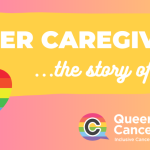Queering Cancer and The Conversation Project’s Kate DeBartolo teamed up this month to discuss why conversations about what matters through the end of life are important and applicable for sexual and gender diverse people. Read more about having a say in who you want involved (or not) in your care and ensuring your wishes are understood and respected.
QC: Kate, we know that it’s important for people to have conversations about what matters most to us through the end of life. Most of us want a say in our care but sometimes we put off these kinds of conversations for various reasons. But we also know that for sexual and gender diverse (SGD) people there may be a few things that get in the way of having these kinds of conversations. One example might be selecting a health care proxy (that’s the one person who speaks on your behalf if you can’t make your own health care decisions). If we’re estranged from our birth family, we might want to ensure our partner, or a trusted friend can speak about our health care wishes rather than a family member if there’s ever a time when we can’t speak for ourselves. We might be used to feeling unsafe or unheard in health care situations, and many SGD people may have had to struggle for legal recognition, having loved ones included in decisions, and being able to access affirming care.
Knowing that these kinds of conversations are about how someone wants to LIVE through the rest of their life — we have a few questions about what The Conversation Project has learned, and how this topic might be applicable to the Queering Cancer community.
Q1: When it comes to sharing your wishes, is the legal documentation or conversation more important?
KD: Our name is a bit of a giveaway about how strongly we believe in the importance of conversation. Legal and medical documentation is wonderful but doesn’t do us much good if it sits in a filing cabinet somewhere and no one knows about your answers. We believe that conversations — listening and asking follow-up questions — provide a wonderful and unique opportunity to clarify what matters to you and avoid conflict among decisions makers. That said, for the SGD community, I see an added value in having the written documents in order, particularly as it relates to who you choose as a proxy. If there is someone you specifically do or do NOT want involved in your decision making who isn’t a legally-recognized spouse or family member, that is important to have on file.
My advice would be to ensure that your health care team knows who your proxy is and clearly states that in your medical records. Tell other friends or family so they can keep an eye out for anyone swooping in uninvited. If your health care team’s records don’t match your name, pronouns, or gender, spending time to solve that now can be worthwhile. (Many more health systems are picking up on this and making it easier in their software). Spend some time thinking about other items that would feel affirming to you that would be important for people to know — the types of clothes you want on hand and grooming practices that are important to you to keep up. (Nothing is too small — we’ve had people share how much they want their chin hairs plucked and manicures maintained in the same breath as they share their opinions on pain management). The really important thing here is to be sure to TELL other people. Don’t leave it up to others to assume what you might want.
Q2: What are some examples you’ve seen about how people want to be involved in their care or the type of care they want?
KD: We’ve seen a total range of reactions to this — and that’s one reason why we emphasize conversations so much. Conversations clarify what matters to YOU so others can work to honor that. We’ve found that the concept of autonomy isn’t always a given. Some people want to be really involved and are explicit about care they do and don’t want. Others don’t have a very strong preference. There is no right or wrong answer to how involved someone wants to be — but understanding it can be helpful for your health care team and for your proxy. If you don’t have strong feelings, that’s worth sharing and talking about. Some people tell their proxy, “I want you to do whatever makes you feel most comfortable at the moment,” while others who feel strongly might say, “here’s a list of exactly how I want you to approach certain situations that might come up.” Similarly, our tools offer ways to reflect on whether you’re concerned about receiving “too much” or “too little” treatment. There’s a big range of response here, too. Some folks want every possible trial and opportunity for a curative solution or more time, and others want to focus on pain management or quality of life.
Q3: What tips do you have to start these conversations/ice breakers?
KD: This blog is a great start! Try telling someone that you’ve heard about The Conversation Project and realized you wanted to talk more about what matters most to you/them. If you have a favorite movie/book/TV series that includes scenes of health care issues — ask, “What do you think about that?” Or think about a family/friend/celebrity and ask, “What do you think about what they chose? Would you want the same?”
Recognize these conversations don’t always happen all in one sitting. We’re trying to encourage more open communication. It might come in smaller, bite-size pieces and be ongoing. It’s helpful to do it in a setting where you think your person will be open to it. I also want to mention that emails or texts can be a good way to get things started for someone who might not be comfortable talking about it. For example, send your person an email with your thoughts that could be reviewed if the time ever comes where they need it, or send a text saying you’d love to talk about this the next time you’re together. We have a blog with a few more tips
The other thing we recommend is approaching this conversation with your current health in mind. You don’t need to try to address every hypothetical medical scenario that might play out in the future (honestly, there’s no way to cover all of that!). Focus on what matters to you right now if you needed someone to speak on your behalf. You can always revisit the conversation over time if something changes in your medical status.
Q4: What changes or adaptations have you made with your resources for SGD people?
KD: We’ve worked hard while creating and editing our resources to hopefully ensure that anyone reading them would see themselves reflected in the materials. We got feedback from folks in the LGBTQ+ community about photography and guidance on illustrations we commissioned. A few years ago, we looked at our guides with fresh eyes and removed gender binary language when not referencing a specific story, using the singular “they” pronoun and the nongendered words parent/sibling/child. We don’t assume heteronormative relationships or monogamy as the standard. We believe these conversations are universal and extra important for those who may be marginalized by society at large — and especially within the health care system. We are always open to feedback and really appreciate when people take the time to share suggestions with us on how to better serve them or their community.
Q4 – Any other tips, suggestions, or things you’d want readers to know?
KD – Don’t wait — start the conversation this week! We often say “it always seems too soon until it’s too late” — and conversations are a great way to clarify what matters most to you. You can have a say in your care and we’re here to help. Everything The Conversation Project offers is free and available in English, Spanish, and Chinese. If we can help answer any additional questions or if readers have ideas for us on how to reach larger audiences, please reach out.


